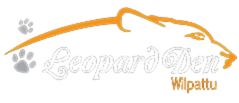About Us
Home / About
Take a glimpse of wild leopards
Leopard Den is a no frills, low cost hotel, ideal for adventure and safari enthusiasts.
Stay over at the Leopard Den to make it a convenient and easy going trip. Located just 7 km from the entrance of Wilpattu National Park,

Wilpattu National Park in Srilanka
Wilpattu is a park located on the island of Sri Lanka. The unique feature of this park is the existence of natural lakes, sand-rimmed water basins or depressions that fill with rainwater. Located in the Northwest coast lowland dry zone of Sri Lanka. The park is located 30 km west Anuradhapura and located 50 km north of Puttalam, approximately 180 km from Colombo. The park is 131, 693 hectares and ranges from 0 to 152 meters above sea level. Nearly sixty lakes and tanks are found spread throughout Wilpattu. Wilpattu is the largest and one of the oldest National Parks in Sri Lanka. Wilpattu is among the top national parks world renowned for its Leopard population.
The Mahavansa records that in 543 BC Prince Vijaya landed at Kudrimalai Point (Horse Point), married Kuweni and founded the Sinhalese race. In 1905 the area was designated a sanctuary and in 1938 it was upgraded to the National Park status.
The Annual Rainfall is about 1000mm and the annual temperature is about 25 to 30 degrees. Inter-monsoonal rains in March and the northeast monsoon (December – February) are the main sources of rainfall.
There are many types of vegetation to be found in Wilpattu; Littoral vegetation, including Salt grass and low scrub monsoon forest with tall emergents, such as Palu (Manilkara hexandra), and Satin (Chloroxylon swietenia), Milla (Vitex altissima), Weera (Drypetes sepiaria), Ebony (Disopyros ebenum) and Wewarna (Alseodaphne semecapriflolia).
31 species of mammals have been identified within Wilpattu national park. Mammals that are identified as threatened species living within the Wilpattu National Park are the elephant (Elephas maximus), Sloth bear (Melursus ursinus), leopard (Panthera pardus kotiya) and water Buffalo (Bubalus bubalis). Sambhur, spotted deer, mongoose and mouse are more of Wilpattu’s residents.
The painted stork, the open bill, little cormorant, Sri Lanka Junglefowl (Gallus lafayetii) along with many species of owls, terns, gulls, eagles, kites buzzards are to be found at Wilpattu National Park. Wetland bird species that can be senn in Wilpattu are the Garganey (Anas querquedula), Pin tail (Anas acuta), Whistling teal (Dendrocygna javanica), Spoonbill (Platalea leucorodia), White ibis (Threskiornis malanocephalus), Large white egret (Egretta alba modesta), Cattle egret (Bubulcus ibis) and Purple heron (Ardea purpurea).
31 sThe most common reptiles found in the park are the Monitor Lizard (Varanus bengalensis), Mugger crocodile (Crocodylus palustris), Common cobra (Naja naja), Rat snake (Ptyas mucosus), Indian python (Python molurus), Pond turtle (Melanonchelys trijuga) and the Soft shelled turtle (Lissemys punctata) who are resident in the large permanent Lakes.pecies of mammals have been identified within Wilpattu national park. Mammals that are identified as threatened species living within the Wilpattu National Park are the elephant (Elephas maximus), Sloth bear (Melursus ursinus), leopard (Panthera pardus kotiya) and water Buffalo (Bubalus bubalis). Sambhur, spotted deer, mongoose and mouse are more of Wilpattu’s residents.
